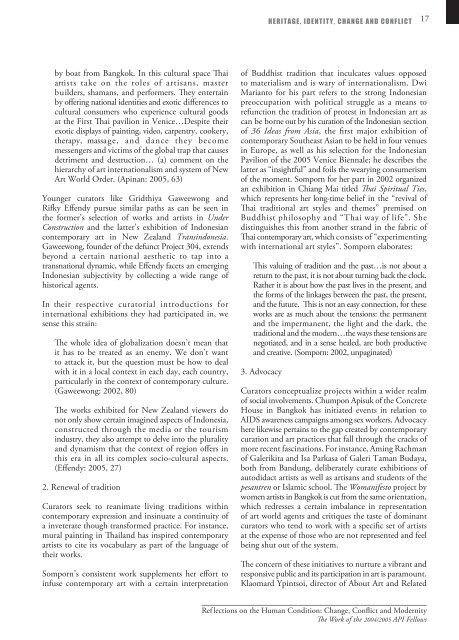Reflections on the Human Condition - Api-fellowships.org
Reflections on the Human Condition - Api-fellowships.org
Reflections on the Human Condition - Api-fellowships.org
Create successful ePaper yourself
Turn your PDF publications into a flip-book with our unique Google optimized e-Paper software.
y boat from Bangkok. In this cultural space Thai<br />
artists take <strong>on</strong> <strong>the</strong> roles of artisans, master<br />
builders, shamans, and performers. They entertain<br />
by offering nati<strong>on</strong>al identities and exotic differences to<br />
cultural c<strong>on</strong>sumers who experience cultural goods<br />
at <strong>the</strong> First Thai pavili<strong>on</strong> in Venice…Despite <strong>the</strong>ir<br />
exotic displays of painting, video, carpentry, cookery,<br />
<strong>the</strong>rapy, massage, and dance <strong>the</strong>y become<br />
messengers and victims of <strong>the</strong> global trap that causes<br />
detriment and destructi<strong>on</strong>… (a) comment <strong>on</strong> <strong>the</strong><br />
hierarchy of art internati<strong>on</strong>alism and system of New<br />
Art World Order. (<strong>Api</strong>nan: 2005, 63)<br />
Younger curators like Gridthiya Gaweew<strong>on</strong>g and<br />
Rifky Effendy pursue similar paths as can be seen in<br />
<strong>the</strong> former’s selecti<strong>on</strong> of works and artists in Under<br />
C<strong>on</strong>structi<strong>on</strong> and <strong>the</strong> latter’s exhibiti<strong>on</strong> of Ind<strong>on</strong>esian<br />
c<strong>on</strong>temporary art in New Zealand Transind<strong>on</strong>esia.<br />
Gaweew<strong>on</strong>g, founder of <strong>the</strong> defunct Project 304, extends<br />
bey<strong>on</strong>d a certain nati<strong>on</strong>al aes<strong>the</strong>tic to tap into a<br />
transnati<strong>on</strong>al dynamic, while Effendy facets an emerging<br />
Ind<strong>on</strong>esian subjectivity by collecting a wide range of<br />
historical agents.<br />
In <strong>the</strong>ir respective curatorial introducti<strong>on</strong>s for<br />
internati<strong>on</strong>al exhibiti<strong>on</strong>s <strong>the</strong>y had participated in, we<br />
sense this strain:<br />
The whole idea of globalizati<strong>on</strong> doesn’t mean that<br />
it has to be treated as an enemy. We d<strong>on</strong>’t want<br />
to attack it, but <strong>the</strong> questi<strong>on</strong> must be how to deal<br />
with it in a local c<strong>on</strong>text in each day, each country,<br />
particularly in <strong>the</strong> c<strong>on</strong>text of c<strong>on</strong>temporary culture.<br />
(Gaweew<strong>on</strong>g: 2002, 80)<br />
The works exhibited for New Zealand viewers do<br />
not <strong>on</strong>ly show certain imagined aspects of Ind<strong>on</strong>esia,<br />
c<strong>on</strong>structed through <strong>the</strong> media or <strong>the</strong> tourism<br />
industry, <strong>the</strong>y also attempt to delve into <strong>the</strong> plurality<br />
and dynamism that <strong>the</strong> c<strong>on</strong>text of regi<strong>on</strong> offers in<br />
this era in all its complex socio-cultural aspects.<br />
(Effendy: 2005, 27)<br />
2. Renewal of traditi<strong>on</strong><br />
Curators seek to reanimate living traditi<strong>on</strong>s within<br />
c<strong>on</strong>temporary expressi<strong>on</strong> and insinuate a c<strong>on</strong>tinuity of<br />
a inveterate though transformed practice. For instance,<br />
mural painting in Thailand has inspired c<strong>on</strong>temporary<br />
artists to cite its vocabulary as part of <strong>the</strong> language of<br />
<strong>the</strong>ir works.<br />
Somporn’s c<strong>on</strong>sistent work supplements her effort to<br />
infuse c<strong>on</strong>temporary art with a certain interpretati<strong>on</strong><br />
HERITAGE, IDENTITY, CHANGE AND CONFLICT<br />
of Buddhist traditi<strong>on</strong> that inculcates values opposed<br />
to materialism and is wary of internati<strong>on</strong>alism. Dwi<br />
Marianto for his part refers to <strong>the</strong> str<strong>on</strong>g Ind<strong>on</strong>esian<br />
preoccupati<strong>on</strong> with political struggle as a means to<br />
refuncti<strong>on</strong> <strong>the</strong> traditi<strong>on</strong> of protest in Ind<strong>on</strong>esian art as<br />
can be borne out by his curati<strong>on</strong> of <strong>the</strong> Ind<strong>on</strong>esian secti<strong>on</strong><br />
of 36 Ideas from Asia, <strong>the</strong> first major exhibiti<strong>on</strong> of<br />
c<strong>on</strong>temporary Sou<strong>the</strong>ast Asian to be held in four venues<br />
in Europe, as well as his selecti<strong>on</strong> for <strong>the</strong> Ind<strong>on</strong>esian<br />
Pavili<strong>on</strong> of <strong>the</strong> 2005 Venice Biennale; he describes <strong>the</strong><br />
latter as “insightful” and foils <strong>the</strong> wearying c<strong>on</strong>sumerism<br />
of <strong>the</strong> moment. Somporn for her part in 2002 <strong>org</strong>anized<br />
an exhibiti<strong>on</strong> in Chiang Mai titled Thai Spiritual Ties,<br />
which represents her l<strong>on</strong>g-time belief in <strong>the</strong> “revival of<br />
Thai traditi<strong>on</strong>al art styles and <strong>the</strong>mes” premised <strong>on</strong><br />
Buddhist philosophy and “Thai way of life”. She<br />
distinguishes this from ano<strong>the</strong>r strand in <strong>the</strong> fabric of<br />
Thai c<strong>on</strong>temporary art, which c<strong>on</strong>sists of “experimenting<br />
with internati<strong>on</strong>al art styles”. Somporn elaborates:<br />
This valuing of traditi<strong>on</strong> and <strong>the</strong> past…is not about a<br />
return to <strong>the</strong> past, it is not about turning back <strong>the</strong> clock.<br />
Ra<strong>the</strong>r it is about how <strong>the</strong> past lives in <strong>the</strong> present, and<br />
<strong>the</strong> forms of <strong>the</strong> linkages between <strong>the</strong> past, <strong>the</strong> present,<br />
and <strong>the</strong> future. This is not an easy c<strong>on</strong>necti<strong>on</strong>, for <strong>the</strong>se<br />
works are as much about <strong>the</strong> tensi<strong>on</strong>s: <strong>the</strong> permanent<br />
and <strong>the</strong> impermanent, <strong>the</strong> light and <strong>the</strong> dark, <strong>the</strong><br />
traditi<strong>on</strong>al and <strong>the</strong> modern…<strong>the</strong> ways <strong>the</strong>se tensi<strong>on</strong>s are<br />
negotiated, and in a sense healed, are both productive<br />
and creative. (Somporn: 2002, unpaginated)<br />
3. Advocacy<br />
Curators c<strong>on</strong>ceptualize projects within a wider realm<br />
of social involvements. Chump<strong>on</strong> <strong>Api</strong>suk of <strong>the</strong> C<strong>on</strong>crete<br />
House in Bangkok has initiated events in relati<strong>on</strong> to<br />
AIDS awareness campaigns am<strong>on</strong>g sex workers. Advocacy<br />
here likewise pertains to <strong>the</strong> gap created by c<strong>on</strong>temporary<br />
curati<strong>on</strong> and art practices that fall through <strong>the</strong> cracks of<br />
more recent fascinati<strong>on</strong>s. For instance, Aming Rachman<br />
of Galerikita and Isa Parkasa of Galeri Taman Budaya,<br />
both from Bandung, deliberately curate exhibiti<strong>on</strong>s of<br />
autodidact artists as well as artisans and students of <strong>the</strong><br />
pesantren or Islamic school. The Womanifesto project by<br />
women artists in Bangkok is cut from <strong>the</strong> same orientati<strong>on</strong>,<br />
which redresses a certain imbalance in representati<strong>on</strong><br />
of art world agents and critiques <strong>the</strong> taste of dominant<br />
curators who tend to work with a specific set of artists<br />
at <strong>the</strong> expense of those who are not represented and feel<br />
being shut out of <strong>the</strong> system.<br />
The c<strong>on</strong>cern of <strong>the</strong>se initiatives to nurture a vibrant and<br />
resp<strong>on</strong>sive public and its participati<strong>on</strong> in art is paramount.<br />
Klaomard Ypintsoi, director of About Art and Related<br />
Ref lecti<strong>on</strong>s <strong>on</strong> <strong>the</strong> <strong>Human</strong> C<strong>on</strong>diti<strong>on</strong>: Change, C<strong>on</strong>flict and Modernity<br />
The Work of <strong>the</strong> 2004/2005 API Fellows<br />
17

















